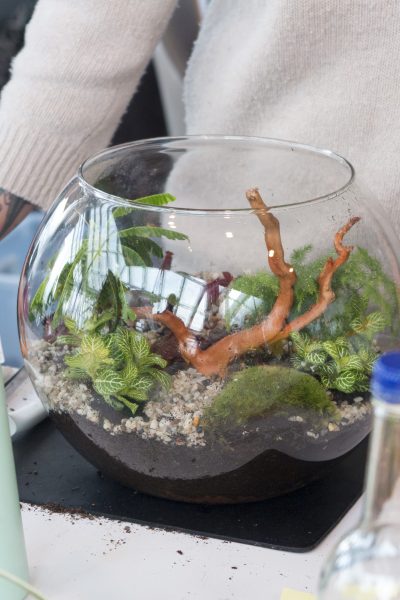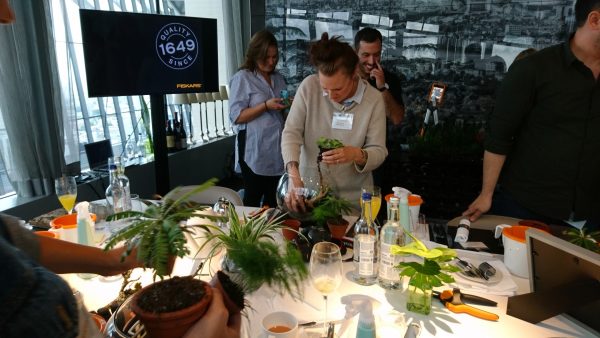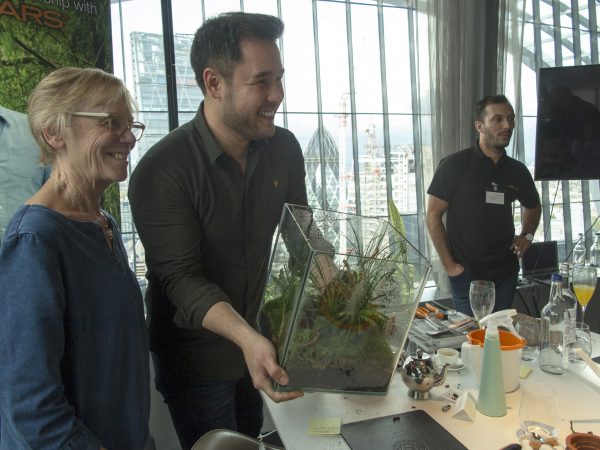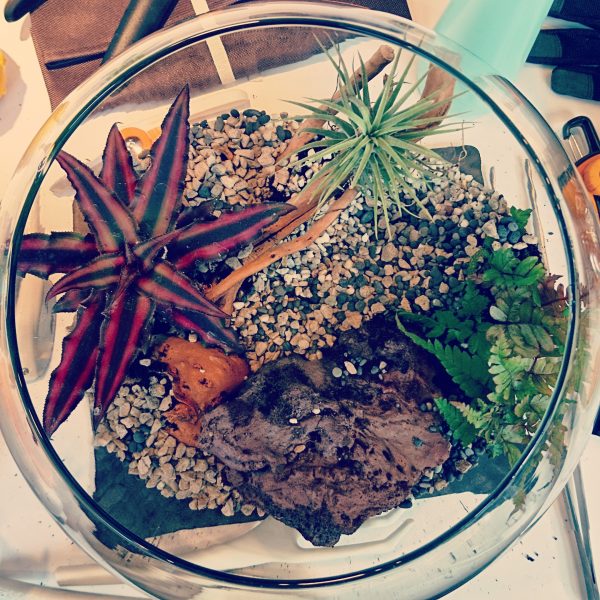The terrarium is back in fashion. You probably last saw one in the 1970s, gathering dust in Great-aunt Agatha’s musty Victorian interior.
Now you might expect to find them in hipster home stores, or on Pinterest and Instagram.

Terrariums are back in fashion. This one was created by lifestyle blogger, Jeska, of the Lobster And Swan blog in our blogger workshop with James Wong and Fiskars.
But, according to TV botanist James Wong, most of today’s terrariums are doomed to die in six weeks. ‘I found more than 100 images of terrariums on Pinterest,’ he said. ‘And I didn’t think any of them were planted well enough to survive more than 6 weeks.’

We met James in the Sky Garden in London’s ‘Walkie Talkie’ building. It’s free to visit, but you have to get timed tickets.
So Fiskars Garden Tools sponsored a small group of lifestyle/garden bloggers – including me – to meet James at the Sky Garden in London to hear his tips for a successful terrarium.
How long should a terrarium last?

James Wong showed a sealed terrarium, which grew happily from 1963-2014 without ever being opened, watered or fed.
And terrariums changed the world we live in today
May I briefly digress into history before giving you James’ tips for making a fab terrarium?
Before Dr Nathaniel Bagshaw Ward invented the terrarium in 1833, it was difficult to ship plants around the world. On deck they were blasted by salt air and wind. Below deck, plants died without light.
Then Nathaniel Ward observed a fern and some moss growing in a sealed jar. He designed and built a ‘Wardian Case’, which was like a greenhouse in a box. It was completely sealed and created its own environment.
The Wardian Case was used to transport plants all over the world. Without it, we wouldn’t have the rubber plantations of Malaysia, the tea industry in India and more (and without the rubber industry, we wouldn’t have the motor car!)
So the terrarium is more than just something which goes in and out of fashion.
How to make a terrarium
First, you need the right container. It needs to be big enough, said James – around 30cm cubed as a minimum. And it can be square, round or bottle-shaped, but not pyramidal.

James Wong illustrating the ‘wrong shape’ for a terrarium.
We were given a choice of square and round terrariums to plant. They measured around 25cm high/diameter.

My empty terrarium. It’s around 23 cm high with a diameter of 26cm at its widest. To the right are a lightweight plastic fork and trowel, plus super-long tweezers. Top left you can see snippers for delicate work – use deadheading or flower-arranging snippers.
I had trouble finding similar sized ones online, but this pentagon terrarium is about the same size.
Note: there are some affiliate links in this post, which means you can click through to buy. If you do, I may receive a small fee.
Quite a challenge to take home on the train – but much more likely to survive longer than 6 weeks.
Equipment…
A small plastic (or other non-sharp edged) lightweight spade, plus snippers or small scissors for trimming plants in a confined space. Add long pair of tweezers and a small container or funnel for adding the soil to the terrarium.

We get started- adding grit and soil to our terrariums…Instagramming the process….and two James Wongs apparently look on…
Drainage and soil…
You need a base layer for drainage in your terrarium. James showed us some lightweight clay pebbles, similar to this horticultural grit.

This is the right amount of grit to provide drainage for your terrarium.
And being mean with the soil is another common terrarium mistake, according to James. You need a good 30cm of potting soil.

Add sufficient soil to your terrarium.
Choose your plants carefully
Glass filters UV light, says James. Which means that a terrarium is suited to shade-loving plants, not sun-loving ones like cacti. You can’t get round it by putting the terrarium in direct sunlight either, as it will heat up too much.
Secondly, you need small plants. Not young ones. There is a difference.

To make your terrarium look natural, James advises that plants grow naturally at an angle. Don’t plant everything growing straight upwards.
When I googled ‘best plants for a terrarium’, I discovered people recommending things like Areca palms, which may start off small, but which grow up to 3ft-6ft high.
James bought a selection of plants for us to choose from. They included Mini ferns, peperomia, helxine (known as Mind Your Own Business) plus moss and airplants.
Terrarium design tips
James said that we needed to start with a theme, and that he would judge our terrariums ‘along RHS Chelsea rules.’
That means that you aren’t judged according to whether the judge likes your garden, but on whether you fulfilled the brief.
I decided to choose ‘Australia’.
And the other thing to remember, says James, is that human beings were originally ‘forest edge dwellers.’ Our early ancestors probably lived at the edge of the forest, using the trees for shelter and to hide from predators. But we needed open spaces in order to forage for greenery and hunt for game.

Lifestyle blogger, Melanie of the ‘slow living’ ‘Geoffrey and Grace’ blog working out the ideal balance between greenery and open space.
The ideal human landscape, he says, is at least one-third open. Don’t stuff your terrarium with wall-to-wall plants.
Different heights
Few landscapes are completely flat. So add different heights to your terrarium.
So James produced lightweight chufa rocks and miniature spiderwood branches to help us make our terrariums three dimensional.

Bloggers adding twigs and chufa to create different heights.
Cover all the earth
Bare earth doesn’t exist in nature, according to James. He gave us a choice of adding moss or gravel – or both, so that we didn’t leave any bare earth.

A good tip from James: in nature gravel comes in lots of different sizes. In shops, gravel is sold in packets of a similar size. Buy two different sizes of gravel to look realistic.
An hour later…
We finished, and James came round to judge us.

Me and my terrarium. This theme business isn’t as easy as it sounds. I’d originally planned to create something like my brother-and-sister-in-law’s hillside garden in Australia, which is green with tree ferns and conifers. I ended up thousands of miles out, creating a desert. Respect to Chelsea garden designers for sticking to a brief.
James was encouraging about all the terrariums, but awarded the well deserved first prize to Stephanie Donaldson of The Enduring Gardener for her ‘Borrower’s Jungle’ (based on The Borrowers, the novel about miniature people).

Stephanie Donaldson and The Borrowers’ Jungle.

And here’s my terrarium, all Instagrammed (I gave it a retro filter – Nashville – in hommage to the terrariums of my university days…) If you fancy connecting on Instagram, join me here.
And afterwards…
Then James advised us to soak the compost thoroughly, but not to water more often than once a fortnight after that. ‘You can see if the compost looks dry,’ he added. ‘That’s the time to water.’ However, it’s a good idea to spritz the occasional spray on the leaves, too.
Place the terrarium somewhere reasonably light, but not in strong direct sunlight.
Last week I looked at the 2018 garden trends. The biggest one is that after about a decade of the ‘garden as an outside room’, we are now entering the era of the home as an ‘inside garden.’
This means pot plants, terrariums, air plants, grow kits and more. It’s fuelled by the fastest-growing group of plant buyers today – the ‘Millenials.’
While I’m definitely no Millenial, I’m excited about this new direction for plants. I really enjoyed learning about terrariums from James (thank you, Fiskars!).
And if your terrarium doesn’t last fifty years, that doesn’t mean you’re a terrible gardener. ‘Plants die,’ says James cheerily. ‘And I’ve killed thousands.’ After all, gardening is a learning process….
The post How to make a terrarium that won’t die in 6 weeks appeared first on The Middle-Sized Garden.
from The Middle-Sized Garden http://www.themiddlesizedgarden.co.uk/how-to-make-a-terrarium-that-wont-die-in-6-weeks/
No comments:
Post a Comment